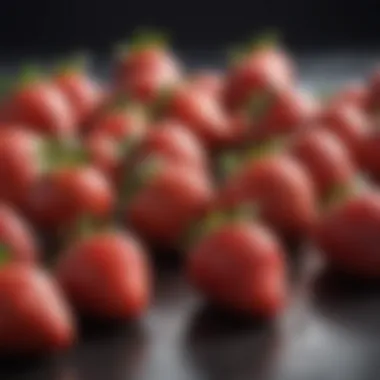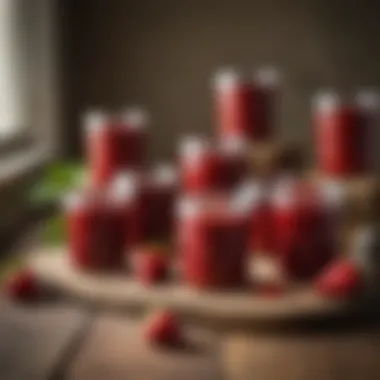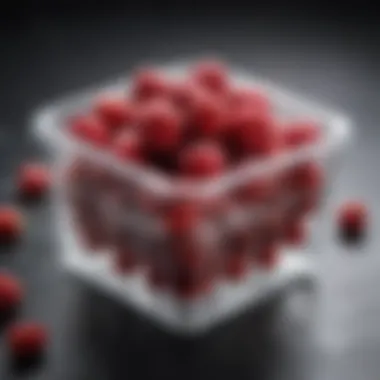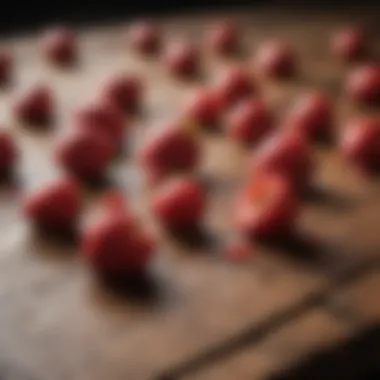Preserving Strawberries: Techniques for Year-Round Enjoyment


Intro
Preserving strawberries maintains their flavor and extends their usability beyond the typical harvest season. Many methods offer effective results, each catering to different preferences and available resources. Understanding these methods empowers home cooks to enjoy strawberries long after peak season.
Ingredients Breakdown
Primary Ingredients
The primary ingredients for almost any strawberry preservation technique are, of course, strawberries themselves. Selecting ripe, fresh strawberries is crucial. Look for berries that are bright red, plump, and free from blemishes. The taste of fresh strawberries directly impacts the outcome of any preservation technique.
Optional Ingredients
Depending on the preservation method chosen, optional ingredients may enhance the final product. Sugar is often used in creating jams or syrup for freezing. Lemon juice can enhance flavor while also acting as a preservative in various techniques.
Essential Kitchen Tools
Some basic tools can significantly streamline the preservation process:
- Sharp Knife and Cutting Board: Essential for removing stems and slicing strawberries.
- Equipment for Freezing: Sheet pans and freezer bags are necessary for freezing. For vacuum sealing, consider a food vacuum sealer.
- Canning Jars: Sterilized jars are a must for canning methods.
- Dehydrator or Oven: For drying strawberries effectively, a dehydrator is optimal, but an oven can work too.
Step-by-Step Preparation
Prepping the Ingredients
Start by rinsing the strawberries under cold water to remove any dirt. Pat them dry gently with a towel to prevent excess moisture.
- Remove the green tops using a sharp knife.
- For some methods, slice the strawberries into halves or quarters to ensure even preservation.
Cooking Techniques and Methods
Different methods require distinct approaches:
- Freezing: Lay strawberries out on a wax paper-lined baking sheet, freeze until firm, then transfer to containers.
- Canning: Prepare syrups and fill jars with strawberries, making sure to leave adequate headspace.
- Dehydrating: Arrange strawberry slices on a dehydrator tray. Set to a low temperature until completely dried.
- Creating Jams: Cook strawberries with sugar and lemon juice. Stir frequently until the desired thickness is achieved.
Assembly and Presentation Tips
When assembling your preserves, consider using labeled containers. This helps in knowing what you stored and makes it visually appealing when stacked in the pantry or fridge.
Dietary Considerations
Gluten-Free Options
Strawberries are naturally gluten-free. Therefore, any method preserving strawberries does not incorporate gluten unless you add non-compliant ingredients. This is excellent news for gluten-sensitive individuals.
Vegetarian and Vegan Substitutes
Most strawberry preservation techniques are compliant with vegetarian diets. For vegans, ensure that any sugars or other ingredients used do not contain animal products. For instance, using agar instead of gelatin can make jams vegan-friendly.
Nutrition Facts & Nutritional Considerations
Strawberries are packed with essential vitamins, particularly vitamin C. They also contain antioxidants and dietary fiber. During preservation, some nutritional aspects may diminish slightly but they retain much of their health properties.
Variations and Customizations
Flavor Enhancements
Consider spices like cinnamon or vanilla during jam preparation for unique flavor profiles. For dried strawberries, adding a sprinkle of sea salt before dehydration can provide a savory kick.
Alternative Cooking Methods
Explore varying your technique; for instance, sous-vide method offers medium control over sweetness through gradual heating when creating syrups—a method not widely employed.
Pairing Suggestions (Sides, Drinks, etc.
)
Strawberries can combine well with many ingredients. Consider pairing preserved strawberries with yogurt or incorporating them into smoothies. They are also delightful additions to salads or even cocktails.
Common Common Questionss and Troubleshooting
Frequently Asked Questions
Q: How long will frozen strawberries last? A: Frozen strawberries can last up to a year if stored properly.
Q: Can I preserve strawberries without sugar? A: Yes, alternatives like honey or dissolving berries in fruit juice can work.
Common Mistakes to Avoid
Avoid using overripe strawberries as they impair the quality of the preserved product. Also, ensure all containers are properly sterilized before filling.
Solutions to Potential Problems


If strawberries are freezer-burned, try using them in smoothies where the texture won’t be as critical. For jams that don't set well, additional cooking or pectin can remedy this.
Understanding these methods enriches your experience as a cook and gives greater pleasure in both preparing and enjoying strawberry preserves.
Understanding the Need for Preservation
Preserving strawberries serves multiple purposes that impact both nutrition and enjoyment. It extends the lifespan of these fruits beyond their natural ripening period. This ability to store the flavor and quality influences how we incorporate fruits into diets year-round. Understanding the different preservation methods can enhance cooking knowledge and lifestyle choices relating to health and enjoyment.
Nutrition plays a crucial role in the preservation conversation. Strawberries are rich in vitamins, minerals, and antioxidants. When fresh, strawberries should reach consumers at their peak maturity to secure these benefits. However, freshness isn’t guaranteed after harvesting. By choosing effective preservation techniques, one can capture and maintain the nutritional content of strawberries for future use.
Nutritional Benefits of Strawberries
Strawberries offer significant health advantages. They are known for their high vitamin C content, pivotal for immune function. Each medium-sized strawberry hosts about 25 calories, making it a favorable choice for weight management. Environmental and agricultural factors can dictate the availability of fresh strawberries throughout different seasons. To make the most of their nutritional value, many consumers consider preservation options.
Additionally, strawberries contain dietary fiber and antioxidants, contributing to better digestion and possibly reducing inflammation. These compounds are beneficial regardless of whether strawberries are consumed fresh or preserved. When correctly preserved, the potency of these nutrients can last, allowing for continuous health benefits.
Impacts of Freshness on Flavor and Quality
The sensory qualities of strawberries, particularly flavor and texture, alter as the fruit ages. A freshly picked strawberry provides sweetness and juiciness that gradually dissipates as the fruit over-ripens or begins to decay. This decline can discourage consumption when fresh strawberries are no longer available.
For example, the average shelf life of a fresh strawberry is just a few days. Inadequate storage can hasten spoilage, affecting both texture and taste. Preserving strawberries through methods like freezing, canning, or dehydrating can counteract this degradation, locking in the taste of fresh strawberries and ensuring that high-quality ingredients are available as needed throughout the year.
Harvesting Strawberries: Key Considerations
Harvesting strawberries at the right time and in the right manner is crucial. This section outlines important elements to consider when gathering strawberries, contributing to the preservation methods discussed later. Strawberries that are picked correctly not only taste better but also have a longer shelf life, essential for methods like freezing or canning.
When to Harvest Strawberries
Timing is everything when it comes to harvesting strawberries. The best time to harvest them is when they are fully ripe, as this ensures peak flavor and quality. Strawberries usually ripen late spring to early summer, but various factors can influence this. It is vital to pay attention to the color; ripe strawberries should have a rich red hue without any green or white patches. Additionally, texture plays a role; when gently squeezed, a ripe strawberry should yield slightly to pressure. Lastly, taste testing a few berries can also be helpful. This method allows you to pinpoint the right time based on that specific variety's sweetness.
- Color: A uniform rich red is desirable.
- Texture: Slight softness indicates ripeness.
- Taste: Sample for natural sweetness.
How to Select the Best Strawberries
Selecting strawberries can significantly affect the quality of preserved products. When you are picking your strawberries, look for ones that are firm and free of blemishes or mold. The green caps, also known as calyxes, should be fresh and green, not wilted. It is recommended to harvest them with their green caps attached, as this helps preserve freshness longer.
While purchasing from markets, opt for organic or local farms whenever possible. This often ensures quality and variety. If you must pick from a store, check containers thoroughly for any signs of damage, as one overripe berry can spoil the entire batch.
The quality of berries at the start of preservation makes a significant difference in the taste and longevity of your preserved strawberries.
Taking careful steps during the harvesting process sets a solid foundation, making later preservation methods more effective.
Freezing Strawberries: A Step-by-Step Guide
Freezing strawberries serves as an essential preservation method. This technique maintains the fruit's freshness, flavor, and nutritional benefits longer than many other methods. Contrary to common belief, freezing does not diminish the berries’ quality too much. Instead, when executed correctly, it helps lock in taste and nutrients, allowing enjoyment year-round.
Preparing Strawberries for Freezing
To freeze strawberries effectively, begin by choosing ripe, undamaged fruit. Wash the strawberries gently under cold water. Remove the green tops using a paring knife or simply pinch them off. Ensure the strawberries are completely dry after washing. Excess moisture can lead to freezer burn and jeopardizes quality over time.
Important: Trim the berries as desired, whether you prefer whole strawberries, halved, or sliced. This choice will depend on personal preference and intended use later.
Next, place the strawberries on a clean, dry paper towel for a few minutes to remove any additional moisture. This will help in reducing the formation of ice crystals during freezing.
Optimal Freezing Techniques
When it comes to freezing, there are several methods to consider. The key methods include:
- Single Layer Freezing: Arrange the prepared strawberries in a single layer on a baking sheet. Make sure they are not touching each other. Place this sheet in the freezer for about 2-4 hours. This process prevents clumping and ensures that strawberries freeze individually.
- Pack and Freeze: After the strawberries have turned solid, transfer them into freezer bags or airtight containers. Remove as much air as possible to limit oxidation, which could affect flavor and texture. Label with date for future reference.
- Using Sugar as a Preservative: Some prefer to place sugar over the strawberries before freezing. This process enhances sweetness. The sugar also creates a syrup, which produces a nice texture when thawed.
Storage Guidelines for Frozen Strawberries
Proper storage is key to keeping strawberries in the best condition. Store these fruit in the freezer at a consistent temperature of 0°F (-18°C) or lower. This ensures long-term preservation and minimizes the chance of losing quality.
Use the following tips for optimal storage:
- Avoid Fluctuations: Keep the freezer door closed as much as possible. Frequent openings increase temperature and can harm the preserved strawberries.
- Check for Storage Duration: Although frozen strawberries can last up to 12 months, it's best to consume them sooner for the best taste and quality. Aim for a usage time within 6-8 months.
- Storage Containers: Vacuum-sealed bags are ideal for maintaining quality. If this is not an option, resealable freezer bags or glass containers can work well.
Canning: A Traditional Preservation Method
Canning is one of the most time-honored methods for preserving strawberries. This process not only allows you to enjoy the sweet and juicy flavors of strawberries long after their harvesting season, but also retains much of their nutritional value. By harnessing the principles of canning, you can prevent spoilage and enjoy strawberries in various forms, such as in desserts, sauces, or even as a spread.
When properly executed, canning creates a vacuum seal that protects strawberries from bacteria and mold while locking in their natural flavors. The benefits range from savings in food waste to economic advantages, especially when strawberries are in season or become more affordable.
All these factors underline the relevance of canning as an exceptionall preservation method worth understanding for any strawberry lover.
Essential Equipment for Canning
Before embarking on your canning journey, certain equipment is important. Here are the fundamental items to get started:
- Water bath canner: This appliance enables even heating of jars and ensures they are adequately submerged in boiling water.
- Canning jars and lids: Use sterilized glass jars designed specifically for canning, along with high-quality metal or plastic lids.
- Jar lifter: This handy tool makes it easier to transfer jars safely and without burning your hands.
- Funnel: A funnel can assist in pouring mixtures into jars with precision.
- Bubble remover: Removing air bubbles is crucial for a successful seal and can be achieved with a simple plastic or silicone tool.


Ensure all equipment is cleaned thoroughly. Proper equipment is essential to avoid mishaps during the canning process and to achieve the best results for preserved strawberries.
Canning Process for Strawberries
Canning strawberries requires steering through specific steps to ensure their integrity during preservation. Here’s a step-by-step guide:
- Preparation: Begin by washing your strawberries under cool water. Remove their stems and cut them according to preference, either halved or left whole.
- Sugar and acid: Combine strawberries with sugar and optional lemon juice in a large pot. Depending on your taste, the sugar can bring out the natural sweetness. Crushing the strawberries slightly will release juices to assist in cooking.
- Simmering: Heat the mixture on medium-low for about 10-15 minutes, stirring regularly. The goal is to reach a simmer to dissolve sugar.
- Filling jars: Once the mixture is ready, use your funnel to fill jars, leaving about ¼ inch of space at the top to allow for expansion.
- Sealing: Wipe the rims of the jars to remove any residue before placing lids and applying rings until finger tight.
- Water bath: Load the filled jars into the boiling water bath, ensuring they are covered. Process for about 10-15 minutes.
- Cooling: Once done, remove jars with a jar lifter and place them upright on a clean kitchen towel. Let them cool completely.
Following these steps can lead to successful cans filled with luscious strawberries ready for your future enjoyment.
Tips for Safe Canning Practices
While canning is a great preservation method, safety is paramount. Here’s how to ensure safe practices:
- Use proper equipment: Always select jars specifically intended for canning and avoid reusing non-canning jars.
- Maintain cleanliness: Sterilize everything from jars to utensils, ensuring that potential contaminants are eliminated.
- Follow recipes: Adapt trusted recipes to avoid fermentation or other disastrous results. Stick to food-safe guidelines provided by reputable sources like Ball* or USDA.
- Check seals: After cooling, test seals by pressing in the middle of each lid. If it springs back, it didn’t seal and you should refrigerate and consume soon.
Adhering to these practices will foster a safe environment and enjoyable outcomes when preserving strawberries.
Canning permits you to archive seasonal sweetness without deterioration, ensuring that delightful strawberry flavors are accessible even in distant months.
Understanding the intricacies of canning enhances appreciation not just for the method, but for the experience it provides in making strawberries last, consenting to indulge in their lush essence anytime desired.
Dehydrating Strawberries: Techniques and Tips
Dehydrating strawberries offers an effective way to extend their shelf life while preserving their flavor and nutritional value. This method is ideal for those who want to stockpile fruits for later use, whether in snacks or recipes. People choose dehydration for its teachings in minimalism. It allows for a taste of summer freshness throughout various seasons. Whenever preparing meals, incorporating dried strawberries can elevate the ordinary into something worth noticing.
Choosing the Right Dehydrator
When considering dehydration, the first step is selecting a dehydrator. Not all dehydrators function equally, and a number of factors influence their performance. Look for a model reputed for even heat distribution. Convection fans and temperature control settings are also merits. Budget options may suffice, but investing more ensures smooth and even drying. The size matters, especially if preserving larger quantities of strawberries at one time. Fragrance and flavor hold value, so rich aroma of naturally sun-dried strawberries is a contrast to oven's artificial heating methods.
Preparing Strawberries for Dehydration
Preparation is paramount before dehydration. Begin with thoroughly washing the strawberries. Remove greens and inspect for bad spots. Only use the firm and ripe fruit; softer strawberries tend to be overly moist and dominate drying time. There are various cutting methods to consider. Sliced strawberries at about a quarter-inch thick allow for optimal dryness without being too thin. Soaking in a sugar syrup can enhance flavor, although that is optional. Note a pleasing scent while doing the prep; it predicts good results.
Proper Dehydration Methods
Once preparations are complete, transfer strawberries into the dehydrator trays. It’s important not to overcrowd; proper airflow is essential. Set the temperature between 135°F to 145°F. Time can vary greatly depending on thickness and fruit quality, typically requiring from six to twelve hours. Periodically check to ensure they dry evenly. The strawberries will be ready when they are leathery and not sticky. Store dried strawberries in an airtight container once cool. A cool dark place is preferred for their longevity, with expiring labels detailing types and dates.
Maintaining flexibility while storing ensures strawberries remains recreate-able.
Making Strawberry Jam: A Sweet Preservation Choice
Making strawberry jam offers a delightful way to capture the essence of fresh strawberries in a jar. This method not only allows for year-round enjoyment of strawberries, but it also provides an opportunity to explore flavors and combinations that differ from simply eating the fruit fresh. Strawberry jam becomes a versatile addition to many dishes including breakfast goods, desserts, or even savory setups. Moreover, the jam-making process is a wonderful activity for families and friends, promoting shared experiences that enhance connections.
Ingredients and Equipment Needed
To embark on the jam-making journey, you need specific ingredients and tools. Below is a comprehensive list:
- Fresh Strawberries: About two pounds of ripe strawberries are ideal.
- Granulated Sugar: Roughly three cups will balance the tartness of the berries. Adjust to taste.
- Lemon Juice: A half cup of freshly squeezed lemon juice helps to preserve color and adds a bright flavor.
- Pectin: To allow your jam to set properly; make sure to select the variety suitable for your needs.
- Equipment:
- A large pot for cooking.
- Sterilized jars with lids.
- A ladle for filling jars.
- A funnel to avoid mess.
Ensure all your equipment is clean and sterilized before beginning. Using proper equipment creates a stable environment for making jam, improving the overall outcome.
Step-by-Step Jam-Making Process
The process for making strawberry jam involves a series of steps that turn fresh berries into a luscious spread:
- Prepare Strawberries: Wash, hull, and slice the fresh strawberries.
- Mashing Berries: In a large bowl, mash the strawberries until they reach a desirable consistency. Leave some chunks for texture, if preferred.
- Combine Ingredients: In a big pot, combine your prepared strawberries, sugar, and lemon juice. Let the mixture sit for about 10 minutes to draw out the juices.
- Add Pectin: Sprinkle the pectin over the mixture; stir regularly to incorporate evenly.
- Cook the Mixture: Place the pot on the stove over medium heat. Stir constantly. Allow the mixture to come to a rapid boil. Keep boiling for about one minute while continuously stirring.
- Check Consistency: Perform a test for gelling by placing a spoonful of mixture on a chilled plate and tilting it to see if it holds its shape.
- Fill the Jars: Once the desired consistency is achieved, use the ladle and funnel to fill sterilized jars, leaving a ¼ inch headspace.
- Seal and Process: Wipe rims of jars and place the lids on top. Process the jars in a boiling water bath for the recommended time to ensure preservation.
This step-by-step approach guarantees a well-structured procedure that enhances the likelihood of favorable results.
Storing and Enjoying Your Jam
Once made, properly storing your strawberry jam ensures its longevity:
- Cool Down: Allow the sealed jars to cool on the counter. Listen for the satisfying “pop” of the seals as they cool.
- Storage Location: Aim for a storage place in a cool, dark cabinet, away from direct sunlight. Proper storage conditions prolong shelf life.
- Duration: Jam can last for up to a year when protected from light and humidity. Always check for spoilage before using, particularly after long storage.
Tip for Enjoyment
Strawberry jam can complement many recipes. Consider spreading it on toast or swirled into yogurt as delightful everyday treat.
Discover the flavors offered through your homemade strawberry jam. The simplicity engages and nourishes, allowing you to relish the essence of summer in each bite.
Alternative Preservation Methods
Alternative preservation methods expand the possibilities for maintaining strawberries beyond the more conventional techniques like freezing and canning. These methods allow individuals to get creative with their recipes while ensuring that the strawberries' natural flavors are preserved. Exploring these options connects the consumer more deeply with their food, offering distinct flavors and new culinary experiences.
Strawberry Syrup: A Versatile Option
Strawberry syrup can be a delightful addition in many food contexts, enhancing deserts or even savory dishes. The simple preparation process requires only a few basic ingredients: ripe strawberries, sugar, and lemon juice. Start by washing and hulling the strawberries, then combine them in a pot with sugar and lemon juice. Over medium heat, mash the strawberries gently. The fruit will release its juice and form a syrup.


After simmering for about 10-15 minutes, strain the mixture through a fine mesh. Your syrup can be stored in a clean bottle, ideally in the refrigerator. Using glass containers is suggested, as these are less reactive compared to plastic and can better maintain quality. Important tips while using syrup include:
- Use in salad dressings to give a sweet touch.
- Drizzle over ice cream or waffles.
- Incorporate in cocktails for an added layer of flavor.
This condiment’s versatility makes it a great option for utilizing your strawberry harvest. Home cooks can look forward to incorporating it throughout the year.
Making Strawberry Pickles: A Unique Twist
Pickling strawberries could seem unusual; however, it presents a unique way to enjoy strawberries in a different form. The process adds spice and flavor, creating a condiment that complements many dishes. To make strawberry pickles, gather fresh strawberries, vinegar (apple cider or white wine vinegar works nicely), sugar, and spices,such as cinnamon or nutmeg.
Begin by washing and hullling the strawberries. The next step is simmering vinegar with spices and sugar until dissolved. Pour the hot pickling liquid over strawberries placed in a jar. After sealing, let the mixture cool to room temperature, then refrigerate.
The strawberries will be ready to consume after about 24 hours, but they improve with more time as they absorb flavors. Strawberry pickles can be a unique addition to platters of cheeses or enhance salads.Explore these combinations:
- Serve with grilled meats as a contrast to the savory flavor.
- Slice and place in salads to create unexpected brightness.
- Pair with cream cheese on crackers for an interesting appetizer.
Alternative preservation methods, like creating syrups and pickles, tease the palate with aromas, textures, and flavorful discoveries. Integrating these approaches helps exploit not just the tartness of strawberries but also fosters culinary innovation for quality dishes year-round.
Utilizing alternative techniques for strawberry preservation not only combats fruit waste but also influences diverse cooking experiences.
Understanding Storage Conditions
Understanding how to properly store preserved strawberries can extensively influence the quality and longevity of the fruit. This topic addresses crucial elements that enhance the enjoyment of strawberries over time, allowing consumers to savor their delectable taste well beyond the harvest period. Storage conditions are not merely an afterthought; they play an essential role in preserving flavors, nutrients, and appearances.
The ideal environment for preserved strawberries greatly depends on various factors, including the method of preservation used. Assuming optimal conditions can prevent spoilage and helps the flavor remain fresh. Considerations like temperature control, light exposure, and humidity sound simple, but they have significant ramifications on storage. Hence, acquiring a good understanding ensures your efforts in preserving strawberries yield satisfying results.
Ideal Storage Temperature for Preserved Strawberries
Preserved strawberries benefit from controlled temperatures during storage. Generally, freezing temperatures are critical for frozen strawberries. Keeping them at around -18°C (0°F) retains their flavor and texture. This makes low temperatures essential in hindering microbial growth and enzyme activity that can lead to declined quality.
For canned strawberries, the storage temperature should be mild, ideally around room temperature. They should be kept in a dark, dry place to protect them from light, which can deteriorate their quality. Stored adequately, the jars can hold flavor for one year or more.
In addition, dehydrated strawberries have a sense of flexibility regarding their storage environment. Keeping them dehydrated can usually be done in a sealed container at room temperature. However, their ideal storage is in a cool, dark space to retain quality.
How to Maintain Quality During Storage
Maintaining quality during storage of preserved strawberries rests on variable factors. Here are key methods:
- Choose Appropriate Containers: Use airtight jars or vacuum-sealed bags for storing frozen strawberries. Make sure they are entirely dry.
- Check Storage Conditions Regularly: Particularly with canned preserves, inspect for any signs of spoilage like bulging lids or off-smelling odors.
- Avoid Humidity: Excess moisture can introduce mold. Ensure containers are ventilated.
- Controlled Lighting: Limit light contact especially for canned and dried strawberries, keeping them in dark spaces.
- Rotation Principle: When accessing preserved produces, practice the first in, first out approach to ensure older stocks are used timely.
Using Preserved Strawberries in Recipes
Using preserved strawberries in various recipes offers a way to experience the delightful taste of this berry even when it's out of season. It allows cooks to innovate and incorporate these fruits into diverse culinary creations all year round. Whether someone is a novice or an experienced chef, having preserved strawberries on hand can inspire creativity in the kitchen. It's also a great way to lessen food waste, making it an appealing choice for sustainable cooking.
Incorporating into Desserts and Baking
Preserved strawberries can remarkably enhance desserts and baked goods. First, they're perfect for cakes and pastries. Their natural sweetness complements batters and doughs well. For instance, adding sweetened strawberry pieces or jam between cake layers can create a delightful contrast convenient for birthdays or special occasions.
Second, they shine in tarts and pies. When used as a filling, they add a burst of flavor. A traditional strawberry pie made from preserved fruits may be nostalgic yet innovative as cooks can experiment with spices or complementary flavors, such as orange zest.
Bread and muffins fare wonderfully with preserved strawberries as well. Chunks from leftover preserves can elevate a morning routine by providing unique yet approachable flavor.
Finally, using these strawberries in ice creams can produce quick and flavorful frozen treats. They may be added during the churn process to create rich textures and layers in homemade ice creams.
Savory Dishes that Feature Strawberries
Second, they can ground flavors in sauces. A strawberry balsamic reduction is not only impressive, but it offers an enticing glaze for grilled meats including chicken and pork. The fruity notes coupled with the complexity of balsamic could create wholly delicious experiences for the diner.
Thirdly, preserved strawberries can bring a unique twist to meals, casting a new angle on predictable entrants. A dish like strawberry salsa offers a funky twist for fish tacos while the strawberry's sweetness makes brightness to this preparation .
Keep in mind that the natural sweetness of preserved strawberries can enhance both sweet and savory flavor profiles in a balanced manner. Choose the right recipe to make the most of this versatile ingredient.
Flavorful and resourceful, preserving strawberries takes time and effort, but the results pay off with excellent options across varied recipes. The ability to incorporate these preserved strawberries into meals gives endless opportunities to delight the taste buds.
Final Thoughts on Strawberry Preservation
In concluding this guide, it's essential to reflect on the significance of strawberry preservation methods. Keeping strawberries fresh or repurposed allows the enjoymetn of these fruits through all seasons. Those methods of preservation such as freezing, canning, or dehydrating not only save once-developed strawberries from spoilage but also enhances their chances for incorporation into various dishes. Thus, waste is reduced, giving economical benefits.
Considering variety among these methods is equally important. Each method serves distinct purposes and varies in complexity, cost, and time requirement. Always consider your preferences and the culinary applications you envision when selecting a preservation method. Additionally, understanding the nutrients fruits provide remains crucial. By using these methods wisely, you maintain flavors and nutrients while respecting the effort put into cultivation.
Effective preservation ensures quality strawberries are available throughout the year, benefiting meals, culinary creativity, and vibrant snacks.
Choosing the Right Method for Your Needs
Making informed choices regarding strawberry preservation involves many factors. If your priority is longevity, freezing provides a straightforward, efficient method. On the other hand, canning offers a more vintage―and indeed delicious―preserved option with texture and taste that many see as exceptional. You must also consider preparation time and ease of access to necessary equipment.
Identifying how you prefer to utilize the strawberries further influences this decision. For instance, smoothie enthusiasts might prefer frozen berries, while someone with an inclination towards homemade baking could favor canned jellies or jams. Reflecting on your usage patterns enhances your selection process. Choose what resonates most with your goals in crafting future meals and utilizing harvested fruits effectively.
Beyond Preservation: Enjoying Strawberries Year-Round
The journey does not end with preservation; once stocked, strawberries can enrich meals throughout the year. These preserved treasures can serve multiple roles in varied culinary applications. You may find delights in smoothies, sauces, baked acute sweets, or even savory dishes that crave a hint of sweetness. Enjoy their versatility to cater meals that satisfy different palates. Adapt recipes depending on how and when strawberries are preserved, and experiment with flavors.
Consider the following examples of year-round strawberry enjoyment:
- Smoothies: Frozen strawberries blend well with dairy or plant-based alternatives for quick, refreshing drinks.
- Jams: Strawberries transformed into jams or syrups can enrich toast or pancakes.
- Baking: Canned strawberries elevate cakes and casseroles. They add moistness and flavor depth.
Discerning food lovers should embrace the opportunity to step beyond simple preservation to masterfully innovate in daily cooking. By having strawberries at hand, creativity is fueled constantly, opening doors for delightful culinary experiences year-round.







